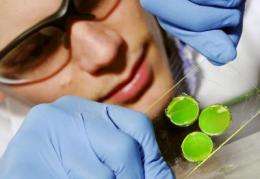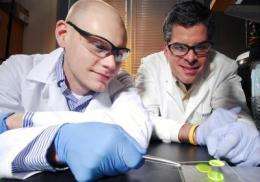Bioengineered materials promote the growth of functional vasculature, new study shows

Regenerative medicine therapies often require the growth of functional, stable blood vessels at the site of an injury. Using synthetic polymers called hydrogels, researchers at the Georgia Institute of Technology have been able to induce significant vasculature growth in areas of damaged tissue.
"This study shows that bio-artificial materials are suitable for promoting vasculature growth and remodeling," said lead author on the study Andrés García, professor and Woodruff Faculty Fellow in Georgia Tech's Woodruff School of Mechanical Engineering and the Petit Institute for Bioengineering and Bioscience. "Because hydrogels are very compatible with biological tissues, they are a promising therapeutic delivery vehicle to improve treatment of peripheral artery disease, ischemic heart disease, and survival of cell and tissue transplants."
Details of the research were published in the early edition of the journal Proceedings of the National Academy of Sciences on December 21, 2009. The work was supported by the National Institutes of Health, the Atlanta Clinical and Translational Science Institute (ACTSI) through the Georgia Tech/Emory Center (GTEC) for the Engineering of Living Tissues, the Juvenile Diabetes Research Foundation, and the American Heart Association.
As part of the research, García and Georgia Tech graduate student Edward Phelps tailored the biochemical and mechanical properties of polyethylene glycol-based hydrogel matrices to enable vasculature to form in and around them. First, the researchers incorporated specific chemical cross-links into the gels so that they would maintain their structural integrity and only degrade in the presence of enzymes called matrix metalloproteinases that are typically expressed by invading cells. They also incorporated into the matrices a protein, vascular endothelial growth factor (VEGF), which stimulates the growth of blood vessels.
"Incorporating these cross-links controlled the release of VEGF from the matrix so that VEGF was only released as the matrix was digested by invading cells," explained García. "This was very important because if you have something solid such as a matrix that cannot degrade, you will not have any vasculature growth into that area."
Adhesive amino acid sequences were also added to the gel so that cells could spread within the gel and interact with nearby endothelial cells undergoing the blood vessel growth process called angiogenesis.
When the researchers implanted the pre-formed hydrogel constructs into small animals, the matrix exhibited constant levels of VEGF for two days followed by a gradual decrease during the following 12 days. When animals were injected with soluble VEGF, a steady decline of VEGF was recorded until 90 percent of the compound was lost within two weeks.
"With the degradable implant that included growth factors, after two weeks we saw that new vessels were growing into and around the implant," noted Phelps.
Additional studies with micro-CT imaging showed a six-fold increase in vascular density at two weeks and a 12-fold increase in vascular density at four weeks with the degradable matrix compared to an injection of soluble VEGF. In addition, the hydrogel degraded in a controlled fashion and was replaced by normal tissue.
"We found that the vasculature was functional and connected to the host circulatory system, which we saw when a contrast agent injected through the aorta reached the vessels in the implant," added García.

To place the hydrogel deeper inside the body than the pre-formed matrix construct would allow and to be able to fill in an injured area of any shape, the researchers developed a liquid material that forms a gel inside the body when exposed to ultraviolet light.
"In reality, most injuries are not well-defined defects so you can't take a pre-formed construct and fill the irregular-sized site," added García. "Instead, you want to be able to access the area in a minimally invasive way and injecting this solution through the skin allows us to do that without surgery."
The researchers injected the VEGF-containing matrix solution into mice suffering from restricted blood flow, known as ischemia, in one leg. After seven days, the animals exhibited a 50 percent increase in blood perfusion to the affected leg and a 100 percent increase in perfusion to the affected foot. The blood flow to the affected leg was greatly enhanced compared to treatment with a non-degradable hydrogel and injection of soluble growth factors alone.
"The engineered matrix containing VEGF performed much better than injecting soluble VEGF, indicating that the delivery vehicle acted synergistically to amplify the effect of the growth factor," noted Phelps.
According to the researchers, the increased perfusion was due to growth factor sequestration in the matrix, resulting in prolonged exposure that persisted as the matrix was degraded and remodeled.
Additional studies are currently being conducted to determine the clinical viability of these hydrogels as therapeutic vascularization therapies to treat peripheral artery disease and ischemic heart disease, and cell transplantation to treat diabetes. Future studies may incorporate more or different growth factors to achieve even more robust healing effects.

















